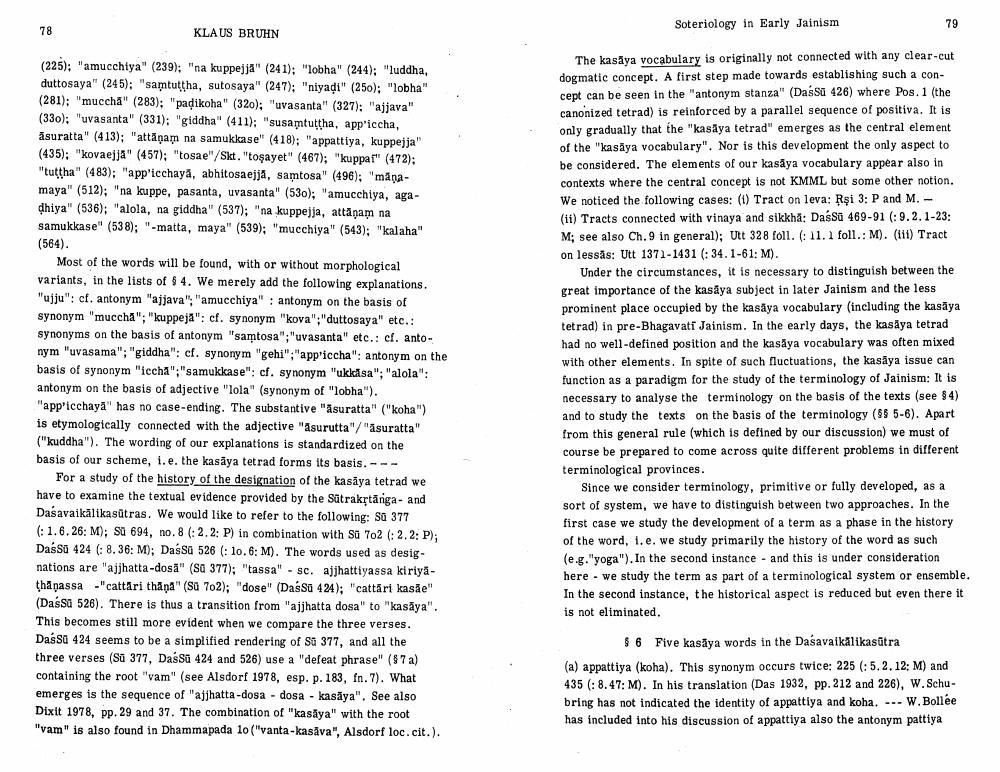________________
78
KLAUS BRUHN
(225); "amucchiya" (239); "na kuppejja" (241); "lobha" (244); "luddha, duttosaya" (245); "samtuttha, sutosaya" (247); "niyaḍi" (250); "lobha" (281); "muccha" (283); "padikoha" (320); "uvasanta" (327): "ajjava" (330); "uvasanta" (331): "giddha" (411); "susamtuṭṭha, app'iccha, asuratta" (413); "attāņam na samukkase" (418); "appattiya, kuppejja" (435); "kovaejja" (457); "tosae"/Skt. "toşayet" (467); "kuppaf" (472); "tuttha" (483); "app'icchaya, abhitosaejja, samtosa" (496); "māņamaya" (512); "na kuppe, pasanta, uvasanta" (530); "amucchiya, agadhiya" (536); "alola, na giddha" (537); "na kuppejja, attāņam na samukkase" (538); "-matta, maya" (539); "mucchiya" (543); "kalaha" (564).
Most of the words will be found, with or without morphological variants, in the lists of § 4. We merely add the following explanations. "ujju": cf. antonym "ajjava"; "amucchiya": antonym on the basis of synonym "muccha"; "kuppeja": cf. synonym "kova"; "duttosaya" etc.: synonyms on the basis of antonym "samtosa"; "uvasanta" etc.: cf. antonym "uvasama"; "giddha": cf. synonym "gehi"; "app'iccha": antonym on the basis of synonym "iccha"; "samukkase": cf. synonym "ukkasa"; "alola": antonym on the basis of adjective "lola" (synonym of "lobha"). "app'icchaya" has no case-ending. The substantive "asuratta" ("koha") is etymologically connected with the adjective "asurutta"/"asuratta" ("kuddha"). The wording of our explanations is standardized on the basis of our scheme, i. e. the kasaya tetrad forms its basis.--
For a study of the history of the designation of the kasaya tetrad we have to examine the textual evidence provided by the Sutrakṛtānga- and Daśavaikālikasutras. We would like to refer to the following: Su 377
(: 1.6.26: M); Su 694, no. 8 (: 2.2: P) in combination with Suü 702 (: 2.2: P); Dassú 424 (: 8.36: M); DasSü 526 (: 1o. 6: M). The words used as designations are "ajjhatta-dosa" (SG 377); "tassa" sc. ajjhattiyassa kiriyathapassa "cattari thaņa" (Su 7o2); "dose" (DasSu 424); "cattari kasǎe" (Dassa 526). There is thus a transition from "ajjhatta dosa" to "kasaya". This becomes still more evident when we compare the three verses. Dassa 424 seems to be a simplified rendering of SG 377, and all the three verses (Sü 377, DasSü 424 and 526) use a "defeat phrase" ($7a) containing the root "vam" (see Alsdorf 1978, esp. p. 183, fn. 7). What emerges is the sequence of "ajjhatta-dosa-dosa kasaya". See also Dixit 1978, pp. 29 and 37. The combination of "kasaya" with the root "vam" is also found in Dhammapada lo ("vanta-kasäva", Alsdorf loc. cit.).
Soteriology in Early Jainism
The kasaya vocabulary is originally not connected with any clear-cut dogmatic concept. A first step made towards establishing such a concept can be seen in the "antonym stanza" (DasS0 426) where Pos. 1 (the canonized tetrad) is reinforced by a parallel sequence of positiva. It is only gradually that the "kasaya tetrad" emerges as the central element of the "kasaya vocabulary". Nor is this development the only aspect to be considered. The elements of our kasaya vocabulary appear also in contexts where the central concept is not KMML but some other notion. We noticed the following cases: (1) Tract on leva: Rşi 3: P and M. - (ii) Tracts connected with vinaya and sikkha: DasSu 469-91 (:9.2.1-23: M; see also Ch.9 in general); Utt 328 foll. (: 11. 1 foll.: M). (iii) Tract on lessās: Utt 1371-1431 (: 34. 1-61: M).
Under the circumstances, it is necessary to distinguish between the great importance of the kasaya subject in later Jainism and the less prominent place occupied by the kasaya vocabulary (including the kasaya tetrad) in pre-Bhagavati Jainism. In the early days, the kasaya tetrad had no well-defined position and the kasaya vocabulary was often mixed with other elements. In spite of such fluctuations, the kasaya issue can function as a paradigm for the study of the terminology of Jainism: It is necessary to analyse the terminology on the basis of the texts (see $4) and to study the texts on the basis of the terminology (55 5-6). Apart from this general rule (which is defined by our discussion) we must of course be prepared to come across quite different problems in different terminological provinces.
79
Since we consider terminology, primitive or fully developed, as a sort of system, we have to distinguish between two approaches. In the first case we study the development of a term as a phase in the history of the word, i. e. we study primarily the history of the word as such (e.g."yoga"). In the second instance and this is under consideration here we study the term as part of a terminological system or ensemble. In the second instance, the historical aspect is reduced but even there it is not eliminated.
§ 6 Five kasaya words in the Daśavaikälikasūtra
(a) appattiya (koha). This synonym occurs twice: 225 (: 5.2.12: M) and 435 (: 8.47: M). In his translation (Das 1932, pp. 212 and 226), W. Schubring has not indicated the identity of appattiya and koha. -W. Bollée has included into his discussion of appattiya also the antonym pattiya
➖➖➖




